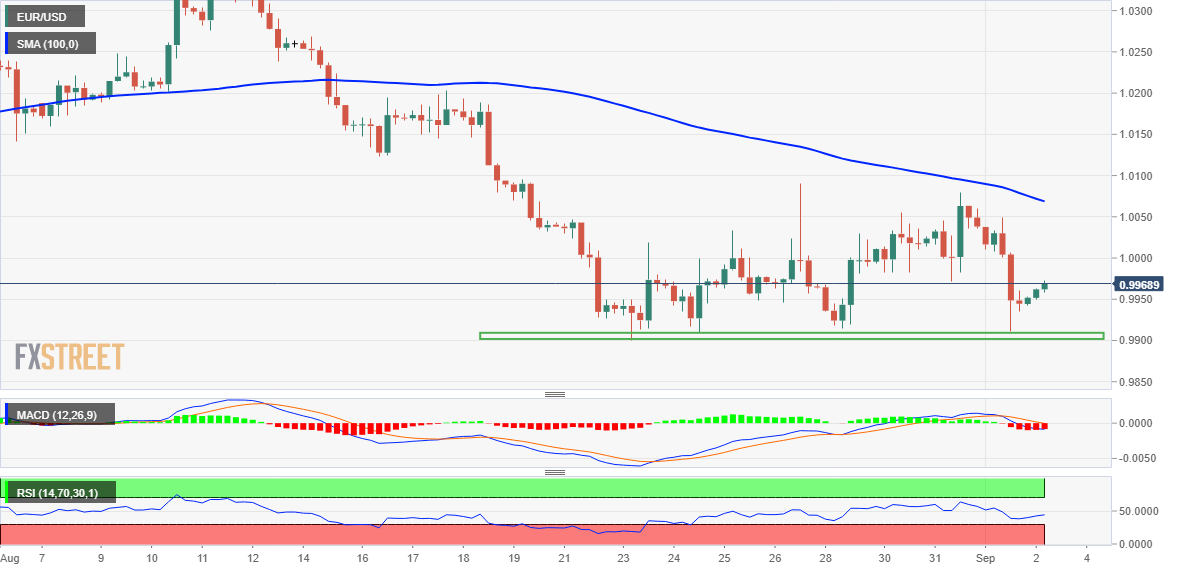- EUR/USD dropped closer to a nearly two-decade low on Thursday amid resurgent USD demand.
- Hawkish Fed expectations, surging US bond yields, recession fears continue to underpin the buck.
- Traders now move on the sidelines as the focus remains glued to the US jobs data (NFP) on Friday.
The EUR/USD pair came under renewed selling pressure on Thursday and dived to the 0.9900 neighbourhood, back closer to its lowest level since December 2002 touched last week. The US dollar caught aggressive bids and reached a fresh two-decade high, which, in turn, exerted heavy downward pressure on the major. The recent hawkish comments by several Fed officials lifted market bets for another supersized 75 bps rate hike at the upcoming FOMC meeting on September 20-21. This, along with upbeat US economic data, continued to underpin the greenback.
The US Initial Jobless Claims unexpectedly fell to 232K during the week ended August 26. Furthermore, the US Manufacturing PMI was revised higher to 51.5 for August from the flash estimate of 51.3 and the ISM Manufacturing Index remained stable at 52.8. The data reinforced expectations for a more aggressive policy tightening by the Fed and pushed the US Treasury bond yields higher. In fact, the yield on the risk-sensitive 2-year US government bond surged to the highest since 2007, while the benchmark 10-year yield rose to more than a two-month peak.
Apart from this, growing worries about a deeper global economic downturn, amid headwinds stemming from fresh COVID-19 lockdowns in China and the war in Ukraine, further benefitted the safe-haven buck. The shared currency, meanwhile, failed to gain any respite from rising bets for a 75 bps rate hike by the European Central Bank at its meeting next week. That said, a later recovery in the US equity markets capped gains for the USD and assisted the EUR/USD pair to stall its sharp intraday decline and edge higher during the Asian session on Friday.
Spot prices hold steady above mid-0.9900s, though lack bullish conviction as the market focus remains glued to the closely-watched US monthly employment details, due for release later during the early North American session. The popularly known NFP report will provide a fresh insight into the economy's health in the face of rising rates and stubbornly high inflation. This, in turn, should play a key role in influencing the near-term USD price dynamics and help determine the next leg of a directional move for the EUR/USD pair.
Technical Outlook
From a technical perspective, the 0.9910-0.9900 area now seems to have emerged as immediate strong support and should act as a pivotal point. A convincing break below will be seen as a fresh trigger for bearish traders and set the stage for an extension of a well-established downtrend. The EUR/USD pair might then accelerate the fall towards the next relevant support near the 0.9850-0.9845 zone before eventually dropping to the 0.9800 round figure.
On the flip side, momentum back above the parity mark might continue to confront stiff resistance near the 1.0050-1.0055 supply zone. This is followed by last Friday’s swing high, just ahead of the 1.0100 mark, which if cleared decisively will suggest that the EUR/USD pair has formed a near-term bottom. The subsequent move up has the potential to lift spot prices to the 1.0150-1.0155 intermediate hurdle en route to the 1.0200 round figure and the 1.0260-1.0270 resistance zone.






